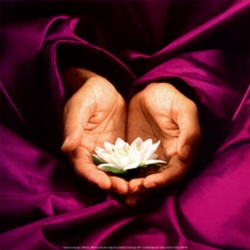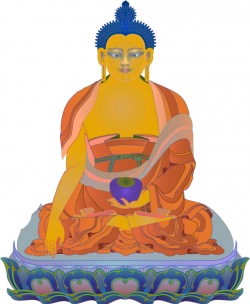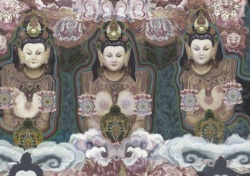Pa Dampa Sanggye
Dampa Sangye (Wylie: Dam pa sangs rgyas, (d.1117 (tib.: pha dam pa sangs rgyas)) often known as Pha Dhampa Sangye.
or 'Father Dampa Sangye', was a Buddhist Mahasiddha of the Indian Tantric Movement who transmitted many teachings based on both Sutrayana and Tantrayana to Buddhist practitioners in Tibet in the late 11th Century.
He travelled to Tibet more than five times.
It was on his third trip from India to Tibet that he met Machig Labdrön.
Dampa Sangye appears in many of the lineages of Chöd and so in Tibet he is known as the Father of Chod, however perhaps his best known teaching is the 'Pacifying Suffering' teaching known variously as:
Shee Ché, Shijed, Zibyed and Zhi-je (Tibetan: ཞི་བྱེད།, Wylie: Zhi-byed).
This teaching became an element of the Mahamudra Chöd lineages founded by Machig Labdron.
Padampa Sangye (Wyl. pha dam pa sangs rgyas; Skt. Paramabuddha) (d.1117) — the great Indian siddha visited Tibet and Bhutan several times.
His main disciple was Machik Labdrön (1055-1149) who founded the lineage of Chö in Tibet and Bhutan.
Both he and Machik Labdrön meditated in caves near Taktsang Monastery in Bhutan.
==Further Reading==
- Padampa Sangye and Chökyi Senge, Lion of Siddhas: The Life and Teachings of Padampa Sangye, translated by David Molk with Lama Tsering Wangdu Rinpoche, Snow Lion Publications, 2008.
- Dilgo Khyentse Rinpoche & Padampa Sangye, The Hundred Verses of Advice—Tibetan Buddhist Teachings on What Matters Most, Shambhala, 2006.
His Tibetan name Pha dam pa Sangs rgyas, translates into Sanskrit as Buddha Paramapitri, literally "Buddha Excellent Father".
He often was identified by the descriptive name Nagpopa, meaning "Black One".
According to a prediction of Padmasambhava he himself would be reborn in the life of Machig Lapdron as Phadampa Sangye. His outer skincolour was black then.
Another text says: "Padampa Sangye (known in India as Paramabuddha) was from southern India, and traveled widely in India, Tibet and China, until his death around 1117 AD.
It is widely believed that Padampa Sangye was a mindstream 'emanation' (tulku) of the 8th century monk Kamalaśīla, one of the early teachers of the Dharma in Tibet.
He spent much time teaching in the Tingri valley, located between Tibet and Nepal, where he founded a monastery.,.
Drum khar Nagpopa: Khampa yogi who meditated in dark retreat for 18 years was -according to Keith Dowman- considered to have been the twelfth of Dudjom Rinpoches/Jiktrel Yeshe Dorje seventeen previous incarnations.
According to Dilgo Khyentse Rinpoche (1910–1991), considered an emanation of Padampa Sangye, the story goes that the great pandit Śāntarakṣita, who was instrumental in transplanting Buddhism from India to Tibet, promised that one of his students would come one day to complete his work.
Kamalaśīla (Tib., Padampa Sangye) fulfilled this prophecy. Khyentse Rinpoche in a 1987 gathering of students at Shechen Monastery, his seat in Nepal, offered a commentary on the Hundred Verses of Padampa Sangye.
In the esoteric oral tradition of Tibetan Buddhism a version of Dampa Sangye's life-story has him travelling to China and teaching there for 12 years, where he was known as Bodhidharma the founder of Zen.
Dampa Sangye is associated with the Tingri area of Tibet, where he lived for many years.
Bardok Chusang Rinpoche is recognized as the incarnation Dampa Sangye. He is a married yogi, living in Kathmandu.
There is a morality tale, allegory and teaching story inherent within the transmission of Chöd to Tibet that has been culturally remembered as a Cham dance.
In this sacred dance, Moheyan is generally depicted as of ample girth goaded by children. Chöd is a product of both the Indian and Chinese transmissions of Buddhism into the Himalaya.
For a discussion of the Dunhuang fulcrum of the entwined relationship of Chinese and Indian Buddhism refer van Schaik and Dalton (2004).
For simplicity, the Indian tantric transmission may be characterized as "gradual" (Tibetan: rim gyis ‘jug pa; Chinese: tun-wu) and the Chinese Chán transmission may be characterized as "direct" (Tibetan: cig car gyi ‘jug pa; Chinese: chien-wu).
It needs to be emphasized that this neat dichotomy in characterization of these two approaches to the Dharma, is only valid for the historical context of the great debate between Kamalaśīla and Moheyan, arranged by Trisong Detsen and even then it is still open to dialectic.
This debate has been named the "Council of Samye" by Giuseppe Tucci but is generally known as the "Council of Lhasa".
According to the general Tibetan tradition, the two years of the debate transpired at Samye, a significant distance from Lhasa.
According to the lore of the orthodox, prevailing Tibetan cultural tradition, Kamalashila, a mahapandita and scholar educated at Nalanda, advocated the "gradual process to enlightenment;
whereas, Moheyan, as a trance and meditation master advocated the "direct awakening of original mind through the nirodha (Sanskrit) of discursive thought, the [[cessation of the [mind of [deation]].
The historicity of this debate has been drawn into question by Gomez (1983) and Ruegg (1992) though this does not lessen its importance in defining the religious and cultural traditions of Tibet.
Kamalaśīla was very handsome and a great orator and historically "won" the debate:
Though there are conflicting primary sources and secondary accounts.
One hagiography asserts that directly after this debate with Moheyan, as Kamalashila was making his way down from the Himalaya to the Indian lowlands, he was incited to enact phowa through compassionate duress, transferring his mindstream to animate a corpse polluted with contagion; and thereby, safely moving the hazard it presented.
As the mindstream of Kamalashila was otherwise engaged, a Mahasidda by the name of Dampa Sangye came across the vacant kuten or "physical basis" of Kamalashila.
Padampa Sangye, was not karmically blessed with an aesthetic corporeal form, and upon finding the very handsome and healthy empty body of Kamalashila, which he perceived as a newly dead fresh corpse, transferred his mindstream into Kamalashila's body.
Padampa Sangye's mindstream in Kamalashila's body continued the ascent to the Himalaya and thereby transmitted the Chöd.
The mindstream of Kamalashila upon endeavouring to return to his kuten was unable to do so and resorted by necessity to the vacant body of Padampa Sangye.
The mindstream of Padampa Sangye continued in this body, and it is in this body that the transmission of Chod was made to Machig Labdrön.
==Tingri Hundred (Wylie: ding ri brgya rtsa)==
Padampa Sangye's last testament to the people of Tingri is known by various names in English 'The Tingri Hundred' or the 'Hundred Verses'. The Wylie of the Tibetan is available on the Internet.



